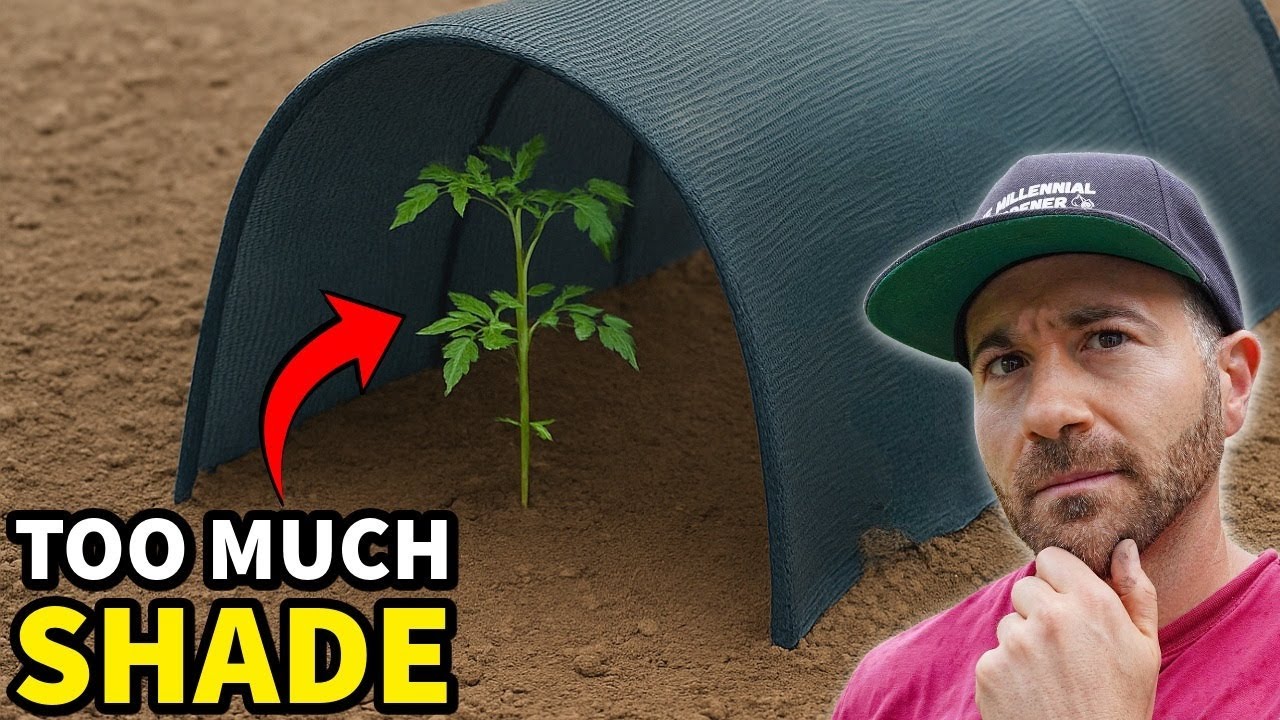Are you worried that your plants might be getting too much shade? If you notice changes in their growth or health, it could be a sign that they’re not getting enough sunlight. In this guide, we’ll help you identify the four key signs that your plants are receiving excessive shade, so you can take the right steps to give them the sunlight they need to thrive.
4 Signs That Your Plants Are Receiving Excessive Shade
Introduction
Gardening, as any seasoned enthusiast will tell you, is an intricate dance with nature’s whims. It’s a game of making the most of what you’re given—be it sun, soil, or the whimsical temperament of a squirrel. But sometimes, your plants seem to be doing their best impression of a wilting, leggy teenager—they stretch out, turn pale, and stop cooperating. You start to wonder: Is it me? Or is my garden secretly trying to tell me something? Ah, yes, the silent clues that indicate your plants aren’t getting enough sunlight. Recognizing these signs transforms a guesswork exercise into an act of botanical kindness. In this article, we explore the four unmistakable signs that your precious greens might be craving more sun—or, worse, are suffering from too much shade. Spoiler alert: mastering this knowledge helps you tweak your garden layout, select the right shade cloth, and turn your black thumb back into green.
The Subtle Victory of Leggy Growth
If you’ve ever grown a tomato and noticed it looking like a string bean after a week, congratulations, you’ve encountered the first sign: leggy growth. Plants that’re starved of sunlight tend to stretch themselves to the limit, trying to reach for those elusive rays piercing through the canopy. The result? Thin, spindly stems that wobble in the breeze like drunken dancers. It’s as if your plant is desperately trying to escape its shady confines, yearning for the glorious days of full sun.
This phenomenon isn’t just a matter of aesthetic displeasure; it signals a fundamental imbalance in photosynthesis. When sunlight wanes, chlorophyll production slows, and plants compensate by elongating in search of light—often at the expense of strength. The more they stretch, the weaker they become, vulnerable not only to pests but also to diseases that thrive in weakened tissues. Think of it as the botanical equivalent of a ghostly, undernourished actor: all associations indicate that direct, ample sunlight—say, 6 to 8 hours of targeted exposure daily—is vital to keeping these plants hearty and productive.
Yet, beware: sometimes, this striving for light can backfire, especially with plants that prefer part-day or dappled shade, like native understory varieties. Sneaky shadow, in the guise of neglect, leads to similar leggy symptoms, but the remedy then involves strategic shade, not more sun. The key takeaway: if your plants are stretching like they’re trying to touch the stars, they’re probably fighting an uphill battle against insufficient light.
Pale Leaves and Patchy Coloration
Now, if your lush green tomatoes have suddenly taken on a pallid, washed-out appearance, it’s like they’re auditioning for a role in “The Walking Dead.” Leaf chlorosis—the yellowing or pale coloration—is a dead giveaway that your plants aren’t getting enough sunlight. Sunlight feeds into chlorophyll, the molecule responsible for that rich green pigment. When it’s missing or insufficient, plants produce less chlorophyll, resulting in leaves that look almost transparent in certain spots.
This isn’t merely a cosmetic concern. Pale, sickly-looking leaves reflect a stress response, indicating that photosynthesis is compromised. Without enough light, energy reserves dwindle, and the plant’s ability to produce fruit and flowers diminishes dramatically. You might notice that fruiting plants like peppers and tomatoes are yielding fewer or smaller produce, which can be heartbreaking if your summer goal was a bumper harvest.
In addition to color loss, you might observe uneven leaf patterns—some foliage appearing vibrant while others are sickly and pale. This discrepancy often points to patchy shade or structural obstructions in your yard. The remedy? It’s not just about dousing your garden in more sunlight but strategically removing obstacles—be it overgrown trees or shade cloths that are too opaque. Concentrating on giving your plants their required amount of sunlight, especially during their peak photosynthesis period, ensures they transition from pale and listless to vibrant and vigorous.
Stunted or Spindly Growth: The Growth Halt
If your once-promising plant now resembles a miniature, frail version of its former self—wildly spindly stems and leaves that seem almost reluctant to develop—it’s a serious red flag. This stunted growth indicates that your plants are receiving insufficient energy from the sun to support robust development. Think of it as trying to bake a loaf of bread with a broken oven—no matter how good your ingredients, without heat, nothing happens.
Plants starved of light allocate resources differently; they prioritize survival over lush growth, and as a result, they become small, awkward, and weak. In particular, flowering and fruiting plants like peppers and tomatoes need a steady, generous dose of sunlight to produce those heavy, red-ripe tomatoes or fiery peppers. When they get only partial sun, they may produce flowers but fail to develop full-sized fruit—an exasperating scenario for any gardener aiming for a bountiful harvest.
Understanding this sign also involves keeping an eye on growth patterns over time. If your plants remain stunted despite adequate watering and fertilization, then excessive shade might be to blame. Adjustments could entail relocating the plant to a sunnier spot or installing a tailored shade cloth that delivers the ideal dappled light—enough for healthy growth but not so much that your understory plant’s defenses weaken, leaving it susceptible to pests and diseases.
Recognizing Shades and Making Corrections
Identifying the problem is half the battle won, but the real skill lies in correcting course. Use these signs—leggy growth, pale leaves, stunted stature—as diagnostic clues to analyze your garden’s layout. Did a new fence block sunlight? Are overhanging trees casting long shadows during crucial hours? Or perhaps your shade cloth, meant to temper the summer sun, is now inadvertently casting too much shadow, hindering photosynthesis.
The proper garden layout is your best ally. Snip away overgrown branches or reposition plants to sunnier spots; employ shade cloth strategically during peak summer months to mimic the gentle dappled light of a forest canopy. Remember: balance is key. Too much shade hampers crop development, especially for fruiting vegetables like tomatoes and peppers that thrive under full sun. Conversely, too little light starves plants, reducing yields and wasting garden space.
If signs point to excess shade, removing or adjusting your shade cloth can make all the difference. Employ tools like insect netting and row covers thoughtfully—they can protect your plants from pests while still permitting enough light for healthy growth. Regularly monitor your garden for visual clues: leggy, pale, or stunted plants are your warning sirens. Acting promptly keeps your garden lively, productive, and—most importantly—full of delicious, sun-kissed produce.
Frequently Asked Questions
1. How can I accurately determine if my plants are receiving too much shade?
Start observing their growth patterns and leaf coloration: lanky stems, pale-yellow leaves, and poor fruit development are classic signs. Use a reflective light meter or simply note the sunlight hours during peak times. Map out your garden’s sunlight exposure throughout the day—areas shaded by structures or trees tend to cast long shadows, especially in early morning and late afternoon. If your plants seem to struggle despite optimal watering and fertilizing, chances are they’re not getting enough light. Adjust your layout accordingly, by relocating vulnerable plants or installing targeted shade provisions.
2. Are all shade signs the same for every plant type?
Not quite. Native understory plants often require shade to thrive; direct sunlight in these cases weakens their defenses and hampers growth. Conversely, vegetables like tomatoes, peppers, and squash demand full sun, typically 6 to 8 hours daily. Recognizing each plant’s natural habitat and light preference is essential. Pale leaves and legginess indicate shade problems for sun-loving crops, while native plants turning pale might signal too much direct sun, leading to stress. Tailoring shade and sunlight exposure by plant type ensures optimum health and yields.
3. What’s the best way to install shade cloth to prevent excessive shading?
Choose the right size and mesh density for your shade cloth based on your specific plants and climate. Installing the cloth high enough above the plants to allow airflow prevents overheating and keeps the canopy dappled, mimicking a forest’s interplay of light and shadow. Tension the cloth evenly across support structures—poles, arches, or frames—to avoid sagging, which can intensify shade in certain areas. Regularly inspect, especially in late summer or early fall, to remove or tighten the cloth if signs of shade excess begin to appear.
4. What tools and supplies are recommended to optimize my garden’s sunlight?
Invest in various shade cloth options—ranging from 30% to 50% shading—and insect netting for pest protection. Pair these with pruning snips for quick corrective cuts, watering wands to deliver even moisture, and organic fungicides if diseases emerge. Fertilizers designed for sun-demanding plants boost resilience, while soil testing kits help ensure nutrients aren’t a limiting factor. Thoughtful garden layout—placing fruiting crops in the sunniest spots and using shade cloth preventive overlays—helps maximize productivity.
5. How do I balance shade management without sacrificing crop yield?
Observation, patience, and adaptive strategies are your best tools. Continually monitor your plants for signs of too much or too little shade, making adjustments as needed. For instance, remove or tighten shade cloth if plants become leggy or pale, or introduce additional reflective surfaces—like light-colored mulch—to bounce extra sunlight into shaded corners. Remember that some native plants and leafy greens thrive in partial shade, so understand each crop’s preference. Striking this delicate balance ensures your garden is a thriving mosaic of healthy, productive plants.
Final Thoughts
Gardening is a relationship—a reciprocal dance of expectation and adjustment. Recognizing the subtle, often overlooked clues that plants send us can transform an ordinary patch of soil into a thriving oasis, buzzing with life and bounty. The signs of shade stress—leggy stems, pale leaves, stunted growth—are not mere flaws but organic signals that guide you toward better gardening practices. Adjusting your approach, installing the right shade cloth, and appreciating each plant’s unique needs create a garden that’s resilient, productive, and full of joy. After all, a garden well-tended is like a well-tuned orchestra—each note, each plant, playing its part in a harmonious symphony of growth.

